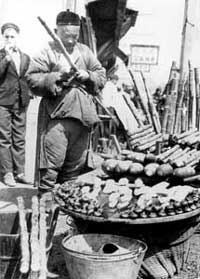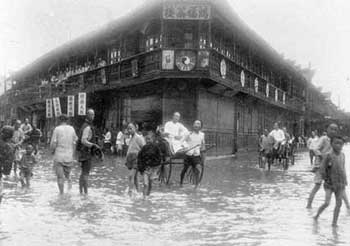|
HOME | SEARCH | ARCHIVE |
|
France-Berkeley project builds photo archive for scholars worldwide
By Cathy Cockrell, Public Affairs
| |
 This Shanghai street hawker is selling what seems to be "imported" fruits and vegetables, as sugar cane does not grow in the Shanghai area. The clothing of the man in the background appear to date from the 1920s or '30s. The photographer is unknown. |
Researchers will, however, glean valuable information from these historical images, and 10,000 more, that Berkeley historian Wen-hsin Yeh and French colleagues are building into a sophisticated database accessible worldwide through the Web.
Photography reached China shortly before Shanghai was opened as a treaty port in 1843 and the city's modern development began outside the old city walls. With this new technology, commercial and amateur photographers (foreigners or, increasingly, Chinese) documented street life, architecture, family scenes, and modes of dress and transportation as the port city near the mouth of the Yangzi River became a major world metropolis.
But photos were not systematically collected in the same way as written texts. Scattered for decades in personal collections, family albums, Christian mission outposts and elsewhere, the lion's share of their information has been lost to scholars - until now.
"These images need to be gathered in one place, and this is what we are doing: creating a visual archive grouping all kinds of photos from the period, for researchers from all fields," said Regine Thiriez, a historian of photography at the Institut d'Asie Orientale in Lyon, France.
With support from the campus-based France-Berkeley Fund, Thiriez, Yeh, French historian Christian Henriot (who chairs the French half of the project) and colleagues on both continents are collecting, digitizing, documenting, captioning and organizing photos of pre-Revolutionary Shanghai.
Thousands of images have been traced to sources in Lyon itself, an old center of learning with long-established ties to China through the silk industry. The Institute d'Asie Orientale there has already scanned 2,000 images of pre-Revolutionary Shanghai from its own collections. And it is arranging to borrow more from other institutions, including Catholic missionary archives and private families.
Since a digital archive is only as good as its technology management, the French and American collaborators also plan to provide state-of-the-art ways of finding and displaying the collected data. That part of the project is happening with the help of the Electronic Cultural Atlas Initiative, an international collaboration, based at Berkeley, that uses information technologies in support of scholarship.
Tools being developed by the cultural atlas will allow researchers to use the Internet to create maps that display data stored on servers anywhere in the world. Those interested in Shanghai will be able to display and analyze data about the photos, along with other topics about Shanghai history indexed by time and place.
Interesting connections between diverse collections of data may result, says Ruth Mostern, who works on collection development for the cultural atlas initiative. For example, in one project under development, scholars were able to correlate three digital maps - of the Roman Empire, pre-Reformation shrines and post-Reformation Protestant churches - to visualize factors contributing to religious revolution.
By its affiliation with the cultural atlas project, Mostern says, the Shanghai photo collection could become one piece of a lively and exciting scholarly interchange. China researchers around the world might electronically visualize their colleagues' research on land use, population, government, trade or material culture - and make exciting new historical connections as a result.
"Shanghai in Images" is one of 14 projects - in fields ranging from cosomology to viticulture, bioengineering and health care policy - selected for awards by the France-Berkeley Fund for 2000.
| |
 Details such as tail haircut and style of dress suggest that this photo by an anonymous photographer was taken at the turn of the 20th century. The onlookers on the tea-house balcony suggest that the flooding is from a heavy tropical rain shower, a common occurrence in Shanghai even today. |
France-Berkeley Fund proposals due Jan. 31
The France-Berkeley Fund supports scientific and scholarly exchange between campus scholars and those at research centers and institutions of higher education in France.
In the seven years since it was established by the campus and the French Foreign Ministry, the endowment has awarded more than $900,000 in seed money to 93 collaborative projects in the sciences, social sciences and humanities.
"We are helping to build an intellectual infrastructure that links Berkeley to a broader world of French and European researchers, and ultimately to a global community of scholarship," says History Professor Peter Sahlins, executive director of the fund.
Projects funded recently include research on prehistoric Polynesian voyaging and island colonization directed at Berkeley by anthropologist Patrick Kirch; a search for supernovae led by campus astronomers Gerson Goldhaber and Saul Perlmutter; and the first phase of a three-year, three-continent conference on the 1960s organized by Berkeley History Professor Andrew Barshay.
The fund is currently accepting applications from ladder-rank faculty members from all campus departments and professional schools at Berkeley, as well as from UC Davis and UC Santa Cruz.
According to Sahlins, the France-Berkeley Fund is especially interested in providing seed money (grants up to $10,000) to bi-national collaborations of junior faculty members, and those whose projects involve innovative research methods or workshops and conferences presenting scholarship. Research teams that include large numbers of graduate students are encouraged to apply.
For an application or information, visit the fund office at 203 Moses Hall, call 643-5799, e-mail fbf@uclink4.berkeley.edu or see the Web site.
Completed applications for the 2001 funding cycle may be submitted electronically via the Web or postmarked by Jan. 31. Winners will be announced in June.
Home | Search | Archive | About | Contact | More News
Copyright 2000, The Regents of the University of California.
Produced and maintained by the Office of Public Affairs at UC Berkeley.
Comments? E-mail berkeleyan@pa.urel.berkeley.edu.